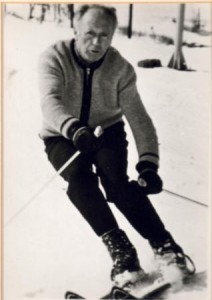 They called him a hockey policeman and there never was a better one than Buck Walton.
They called him a hockey policeman and there never was a better one than Buck Walton.
Never a fancy skater or a fast one, Buck made up for his lack of speed and finesse with his courage, stick handling and dogged determination.
He played on three Collingwood O.H.A. Intermediate “A” championship teams in 1918, 1919 and 1920 and on the runner-up team in 1921.
When the going got tough and the opposition started carrying the sticks high, the call went out for the “policeman”.
He never spared himself and he never made excuses. If he took a butt end in the corner there was no squawking from the “Buckaroo”
He just lowered his head and hit with everything he had. Buck took many beating but he handed out some pretty good lumps himself. No fast skating forward ever came in on Walton with his head down-at least not after the first time.
I remember the night, fifty-four years ago, when the Buckaroo took a bad on big Dick Simple, the great Midland star of that era. Dick stepped deftly aside and Walton took a Barnum and Bailey dive into the end boards. The crowd groaned as his head and shoulders crunched against the planks and his body slipped down to the ice. The legendary Rabbi Fryer skated over to the fans and called out “Get a dust pan and a broom!” Buck was on his feet in a minute, skated over to the bench, took a long drink of water, or whatever, and joined the affray again. Two minutes later he went from end to end and scored.
Back in 1915, he scored a winning goal in Hamilton that put Collingwood into the O.H.A. semi-finals round. He had been knocked out twice during the game. For twenty years, Buck Walton gave everything he had for Collingwood junior and intermediate teams.
Buck and Rabbi Fryer were lured out of retirement in the thirties and turned out to be bad decision.
In a play-off game between Collingwood and Camp Borden for the Georgian Baygroup title, referee Ernie Wortley fingered buck for five cheap penalties and the Buck lost his cool. He dropped his stick and went for the official, the first time he did that in his life. Fryer came to Buck’s assistance, although he really didn’t=t need it, and both players were suspended indefinitely by the O.H.A.
Two years later, Fryer made application and was re-instated. Buck refused to go hat in hand and said. “Let them keep the O.H.A. it’s only a pink tea party now, anyway. Next thing you know they’ll penalize you for spitting out your own teeth”.
He never was re-instated and I was always sorry about that. I tried to persuade him to apply for re-instatement just so he could retire with a clean slate. It was no dice. Buck was just too proud and that application for re-instatement sounded too much like begging to suit the Buck.










